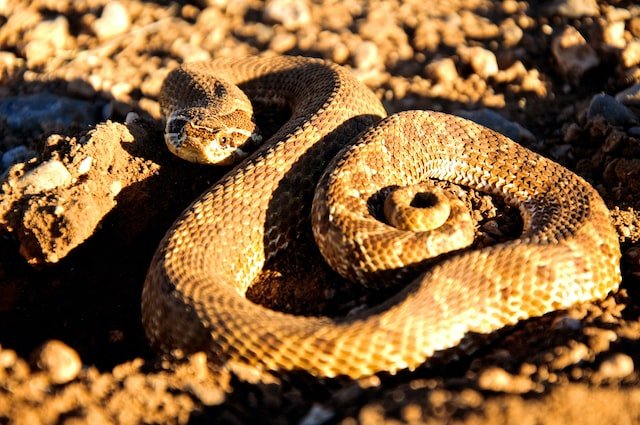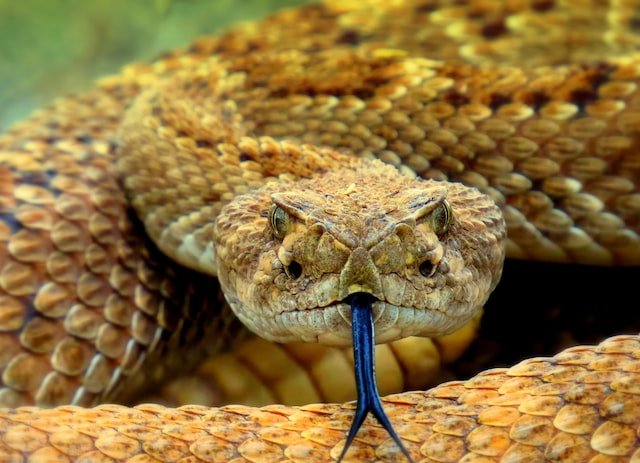The egg-laying rattlesnakes of Central and South America belong to a unique group of snakes known as viperids, or pit vipers. These snakes are characterized by a heat-sensing organ between their eyes and nostrils that helps them detect warm-blooded prey.
This group includes the famous Crotalus durissus, commonly referred to as the South American rattlesnake.
They are highly venomous and found across Central and South America, from Brazil to Mexico. Their habitats range from open grasslands and shrublands to tropical and montane forests.
During mating season, these rattlesnakes can be found aggregating in large groups to lay eggs. Females can lay up to 30 eggs at once and usually hide them in protected places like inside termite mounds. With a very fast gestation period, their young hatch within 40 days, giving birth to the next generation of viperids.
Discover the Types of Egg Laying Rattlesnakes in Central and South America
Rattlesnakes have long been a symbol of danger and the unknown, so it may surprise many to learn that certain rattlesnakes actually lay eggs!
Central and South American rattlesnakes are some of the few venomous snakes in the world that engage in this process, making them a fascinating study for herpetologists and curious readers alike.
Here is a brief overview of these unique creatures and the interesting behavior that sets them apart from the typical vipers that give birth to live young.
The Unique Egg Laying Rattlesnakes of Central and South America
- The Western Hognose Rattlesnake (Crotalus tigris) is one of the few egg-laying rattlesnakes found in the Americas. This snake is found in Central and South America and can reach lengths of up to three feet. This species has distinctive black and white markings, with a light brown underside, and is equipped with the traditional rattle to warn predators away.
- The Blotched Rattlesnake (Crotalus consanguineus) is the other egg-laying rattlesnake species native to Central and South America. This species is typically found at elevations between 800 to 3,000 meters above sea level. This snake has a brown back and sides and a white or light gray underbelly. Like other rattlesnakes, this species is also equipped with a rattle to warn potential predators.

Egg Information
Egg-laying rattlesnakes have been a source of scientific study for some time. One unique thing about these egg-laying rattlesnakes is that they do not use their eggs like other snakes, but rather leave their eggs inside the uterus to be hatched later.
The eggs themselves are covered in a white calcium-rich membrane.
Once the young are hatched, they make their way out of the uterus, still in the white membrane. The hatchlings will then emerge, completely independent and able to survive without their mother’s care.
These two species of rattlesnakes can lay up to six eggs at a time and take two months to hatch. They also prefer to lay their eggs in damp, moist environments and in holes they’ve created themselves.
Rattlesnakes Who Lay Eggs:
- The Cusuco Massachuses, otherwise known as Cusuco Rattlesnake (Crotalus durissus cuscoensis).
- The Papaua Gopher Snake, otherwise known as the Desert Gopher Snake (Pituophis melanoleucus lineaticollis).
- The Atlantic Massachussets, otherwise known as the Cuban Rattlesnake (Crotalus gracilis nubilus).
- The Beaked Alamo, otherwise known as the Mountain Rattlesnake (Crotalus lannomi).
- The West Cuban, otherwise known as the Cuban Mountain Rattlesnake (Crotalus laevifrons).
Egg Information:
Unlike vipers and most other snakes, rattlesnakes lay eggs. Depending on the species, they may deposit one to six eggs per clutch and the eggs are usually buried underground or within rotting logs, piles of vegetation or abandoned mammal burrows.
Generally, the eggs incubate for an average of two months, but some species take slightly longer to reach maturity.
Most rattlesnake eggs are soft and flexible when first laid and slowly become harder as the incubation process continues.
In most cases, the mother leaves the eggs shortly after laying and does not offer any parental protection. The young will emerge in a weakened state, typically around 5 to 6 inches in length.
Rattlesnake Eggs: A Rare Sight in Central and South America
Rattlesnakes are found in a variety of habitats throughout the United States and Mexico, but are less common in Central and South America. What makes rattlesnakes especially rare in Central and South America is the fact that they lay eggs, a behavior which is quite unusual for a reptile.
Where do Rattlesnakes Lay Their Eggs?
Rattlesnakes in Central and South America lay their eggs in sheltered areas like rock crevices and in shallow burrows, similar to their counterparts in the United States. These protected places are typically moist and relatively warm, providing an ideal incubation environment for the eggs.
How Long Does Incubation Last?
The length of incubation varies among species of rattlesnake, but it generally lasts for about 90 days. During this period, the temperature of the surrounding environment plays an important role in the successful hatching of the eggs. If the temperature is too hot or too cold, the embryos inside the eggs will not survive.
How Many Eggs do Rattlesnakes Lay?
Rattlesnakes in Central and South America generally lay anywhere from three to sixteen eggs at one time. However, some species may lay as few as one or two eggs or as many as twenty or more.
Do the Mother Rattlesnakes Protect their Eggs?
Unlike some species of snakes that exhibit maternal care and stay with their eggs to protect them from predators, mother rattlesnakes in Central and South America typically do not protect their eggs. Once the eggs are laid, the mother snake will leave them and not return until they are ready to hatch.
Rattlesnakes in Central and South America are an incredible sight, but even more remarkable is the fact that these reptiles lay eggs. While the number of eggs laid can vary and mother snakes don’t protect them, these unique creatures continue to reproduce successfully.
Final Words
The egg-laying rattlesnakes of Central and South America have been a source of fascination and curiosity for centuries, but scientists still have much to learn about them. We now know that these creatures differ from the more typical species of vipers and other snakes, in that they lay eggs and are somewhat different in their parenting behavior.
As we gain a better understanding of their life cycle and the specifics of their unique incubation process, the mystery and wonder of these unique animals only grows.
Recent Posts
What Does Kiviak and Its Eggs Really Taste Like and How Do You Even Eat It?
Kiviak and its eggs taste like fermented blue cheese mixed with oily game meat, wrapped in a punch of ammonia. This dish, found in Greenland, is made by stuffing hundreds of whole auk birds into a...
Are Ethical Concerns in Egg and Chicken Farming Being Ignored?
Egg and chicken farming has raised significant ethical concerns, affecting both the animals involved and the consumers who rely on these products. The conditions in which chickens are raised, their...

